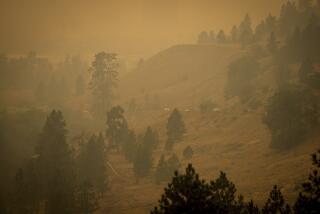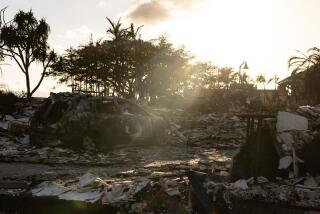Flames of anxiety at the U.S. fire command center in Idaho
The map on the large video screen at the far end of the room provides a real-time snapshot of the forest fires raging across the western U.S.
On this morning, the picture isn’t pretty. It’s ominous in a hold-on-to-your-seat way that casts a pall over two dozen fire analysts, meteorologists and forest experts. They see a growing scourge of fierce yellow and red dots, each representing a new fire, and they furrow their brows.
Alaska is burning.
The incident report for this day, Monday, June 22, at the National Interagency Coordination Center — the nerve center for the white-knuckle job of fire-control nationwide — shows the state at Planning Level 5, the highest possible.
Sixty-four new infernos have been sparked since the day before. In all, 12 large fires burn out of control, with 2,000 firefighters already on the ground.
In drought-baked California, 49 new blazes erupted in the previous 24 hours. The Lake Fire in San Bernardino has roared for days, and on this Monday is still only 21% contained. Two conflagrations further north — the Corrine fire near Merced and the Sky fire near Yosemite — have closed roads and threatened structures.
The fire watchers here at this wooded high-security complex hail from a phalanx of federal agencies — Forest Service, Bureau of Land Management, National Weather Service, National Park Service, Fish and Wildlife Service and Bureau of Indian Affairs.
Previously, they met once a month to pool resources, manpower and ideas. Now they huddle daily. Soon they will meet twice a day.
Summer fire season is here, and this one promises to be a doozy, infusing the command center with the gravitas of the White House Situation Room.
As a reminder of the mission, the walls bear graphic color photographs of hellish fires with their Medusa heads, crackling front ranges and helicopter loads of retardant dumped to smother and kill them. Agency fire managers sit at a center table, consulting paper inventories of manpower and machines.
At 10 a.m., Jeremy Sullens takes the lectern and the analysts stop work to listen. Now 33, the wildland fire analyst faces his 16th fire season. He describes a perfect firestorm, the type that manifests itself only a handful of times each year, a domino-fall of natural events that has led to this day.
“I try not to embellish anything — I don’t want to oversell it,” Sullens will say later. “But I have to sell it enough to make sure the severity of the message gets conveyed.”
And sell he does: The western U.S., already mired in drought, has in the last few days recorded temperatures of 100 degrees or more. Now a series of gathering storms prepares to throw lightning strikes onto the arid land, like matches tossed upon brittle tinder.
Already fire conditions are nearly a month ahead of usual. That means the forests, hills and plains across the West are blistering like it’s late July.
Sullens switches to three computer images of the West showing the ERC, or Energy Release Component, a measure of dry on-the-ground fire fuel. The images show conditions from a week ago, this day and a prediction of things to come a week hence.
The dangerous red ERC areas grow larger with each image, like angry swelling around a sore.
Paltry autumn and spring rains have produced a thin layer of grass that fire coordinators call “fine fuels” soon to brown out, creating a perfect ladder for an opportunistic blaze to climb to the tops of drought-stricken trees.
“It’s an already bad situation that’s about to get worse,” Sullens says.
After the situation meeting, the managers hold their own talks. “This is how many resources I have,” they say, detailing trucks, aircraft and smoke jumpers. “This is where I need to move those resources.”
Those decisions are relayed to the nearby command center, a cavernous room with rows of work cubicles facing a series of computer maps tracing fires and hazardous conditions, where the logistics of firefighting are carried out.
Each year, 80,000 forest fires are reported throughout the U.S., but only the largest are handled here, blazes that scorch 500,000 acres and command the newspaper headlines for days on end.
Randy Eardley, a BLM division chief at the National Interagency Fire Center, says all fires — small, medium and large — are occurring more often.
A half-century ago, many large fires in Idaho that occurred naturally were considered 60-year fires. Now many are back every five years. From 1960 to 2000, an average of 4 million acres of forest burned nationwide each year. Since 2000, annual burn totals have topped 8 million for several years.
In an office down the hall, Ron Dunton, the BLM’s assistant director of fire and aviation, must make two critical telephone calls: Inform swamped Alaska fire officials they won’t receive any more assistance today. And tell fire managers in the Great Basin, a swath taking in parts of California, Idaho, Oregon and Utah, to prepare for the worst. He picks up the phone.
By week’s end, Alaska will still be at Planning Level 5, with fires burning out of control statewide. San Bernardino’s Lake Fire will still refuse to submit, and forecasts will call for lightning statewide.
On Monday, a few hundred yards away, in a compound known as the Loft, smoke jumpers prepare for word they’ll be dropped into wild country enveloped by fire.
The season’s staff level is 74, but many are already deployed in Alaska and elsewhere. With those left, there’s a sense of calm as men repair parachutes at sewing tables, awaiting the fire siren, their cue to check the board to see if their name has come up.
Outside, on the compound grounds, stands the Wildland Firefighters National Monument, three 8-foot-tall statues and markers commemorating the men and women who have died fighting fires.
The 1-acre park was dedicated in 2000 for the 14 firefighters killed in Colorado’s South Canyon fire. Scores of markers have been added since, a reminder of the gritty gambit that results from decisions made here.
The incident report for this day, Monday, June 22, does not include this: At the memorial, a woman sits forlornly facing a marker of a son or daughter, father or mother who went off to fight fires and never came back.
Twitter: @jglionna
More to Read
Start your day right
Sign up for Essential California for news, features and recommendations from the L.A. Times and beyond in your inbox six days a week.
You may occasionally receive promotional content from the Los Angeles Times.







